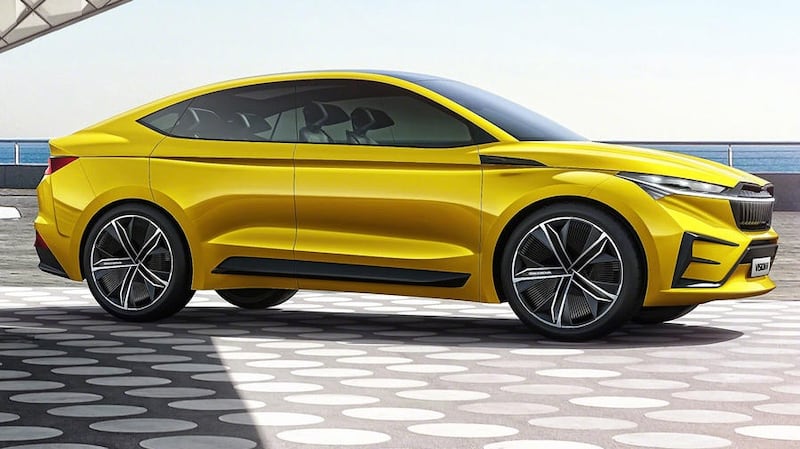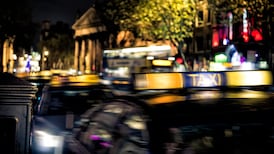Seat and Skoda are both showing off electric car concepts at the 2019 Geneva motor show, and they demonstrate the breadth of models that the Volkswagen Group can spin off from its new MEB electric car chassis.
Having already confirmed that the MEB platform will be shared and licensed with other car makers (starting with the Aachen-based e-Go startup) the VW Group’s two affordable car brands have wheeled out their own battery-powered concepts.
Skoda’s Vision IV concept is the more forward-looking, but arguably the less realistic of the two concept cars. It’s a large (4.6-metres long) SUV-coupe, not dissimilar to BMW’s X6 or Mercedes GLE Coupe. The MEB platform underneath means that the bonnet can be made short, and the wheelbase long, which helps to maximise interior space. The seats are covered in a suede-like material made from recycled PET bottles, while the dashboard is stripped back almost to skeletal status, with floating instrument and infotainment screens.
Outside, the Vision IV is rather more conventional, taking existing Skoda design themes and bulking them up a bit, adding a little more muscle. It wouldn’t be a big stretch to see the overall shape and styling as a potential replacement for the current Superb, while the rear styling owes more than a little to that of the existing (Chinese market only) Kodiaq Coupe.

The biggest change on the outside is the long, thin strip of LED lights that runs around the nose of the ca, bisecting the front grille. Door mirrors are replaced by Audi e-Tron style cameras, while the doors are entirely free from handles and pop open when you wave your hand near them.
Power comes from two electric motors, which power all four wheels with 306hp. Skoda claims that the Vision IV can accelerate to 100km/h in just 5.9secs, but has a one-charge range of 500km, with the usual 30-minute 80 per cent recharge time for the 83kWh battery (although it doesn’t specify what level of charging power is needed to achieve that).
Skoda claims that the Vision IV is capable of automated driving up to Level 3, which is about the same level as the current Audi A8 (assuming you can find a road where that’s legal). It uses a combination of radar, cameras, and laser scanners to do that, and can also communicate with road management systems. Inside there’s 5G connectivity and you can unlock the car and start it using your phone.
Seat’s concept is barely a concept at all. Called the El-Born, it’s a compact halfway house between a hatchback and a crossover, and is said to be about 95 per cent production ready. Indeed, Seat claims that this car will become the second production-ready VW Group model to use the MEB electric car hardware, after Volkswagen’s all-important own ID.
Under the new WLTP economy and emissions tests, the El-Born will put a claimed 420km between charges — short of the original 500km range first claimed for the VW ID, but impressive nonetheless. It’s brisk in its performance too; hitting 100km/h from rest in 7.5secs.
“Mobility is evolving and with it, the cars we drive. Seat is at the forefront of this change, and the el-Born concept embodies the technologies and design philosophy that will help us meet the challenges we face in the future,” said Luca de Meo, president of Seat.
In terms of style, well… While Seat is making much play of the way the windscreen pillars are pulled forward, to maximise cabin space (which should be quite MPV-like, thanks to the El-Born’s flat floor and compact electric motor), and “a double layer spoiler [which] contributes to the aerodynamic performance” there’s no getting away from the fact that the front of the El-Born bears more than a passing resemblance to Tesla’s much-hyped Model 3. In fact, from dead ahead it’s going to be quite difficult to tell the two apart. Seat, with a face of pure innocence, says merely that: “There is no need to take in air to cool the engine so no demand for a grille” but this is either flattery through imitation, or a flip of two fingers at Tesla.
In technical terms, while Seat hasn’t quite revealed the full mechanical setup of the car, it’s likely to use two electric motors, giving it four-wheel drive, to cope with the 204hp that is its quoted power output. It’s also setup for fast charging, sort of. Find a 100kW fast-charger (there are none in Ireland, as yet) and you can recharge the batteries to 80 per cent full in 47- minutes. Hopefully, the new families of 150kW chargers, due to start being installed in Ireland by the IONITY group, will speed that up a bit more.
To try and preserve that range, the El-Born is fitted with a heat pump, which can feed warm air to the cabin without overly draining the battery. Seat claims that the heat pump adds as much as 60km to the overall range.
The interior is relatively conventional, which perhaps reinforces the word coming from within Seat that the El-Born is 95 per cent production-ready, and not a pie-in-the-sky concept car.
Volkswagen’s own MEB-powered concept is the achingly cool Beach Buggy, a battery-powered tribute to the classic sixties Meyers Manx beach buggy, which was built on a Beetle chassis.
The Buggy gets a 201hp electric motor, mounted in the rear and powering the rear wheels of course, and a 62kWh battery for a claimed range of 250km. The concept is dripping with retro-cool touches, and does entirely without a roof, doors, or bootlid but VW says that, actually, it’s about 70 per cent ready for production, and that a short-run version will be built for sale. It’s probably not too big a stretch to see, in the styling of the Buggy, especially around the lights, where VW might be going with a revived Beetle, based on the MEB platform. Such a car has been long-rumoured and has been tacitly admitted to by Volkswagen.











